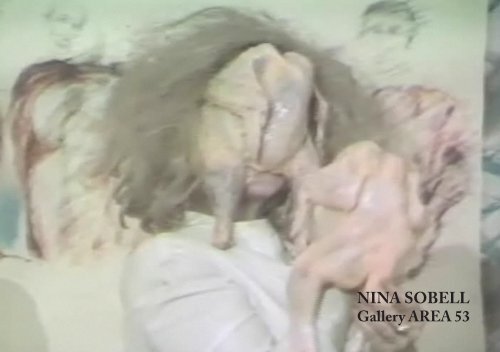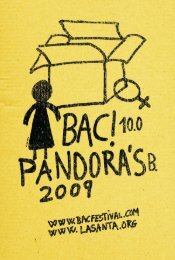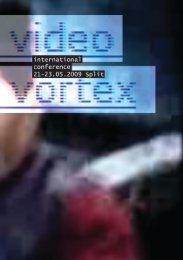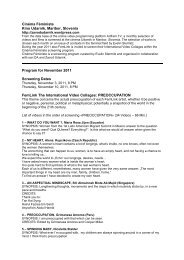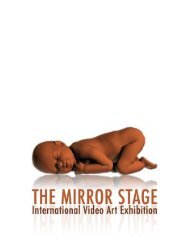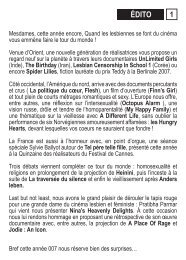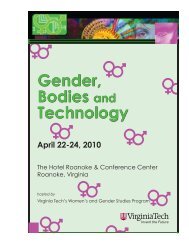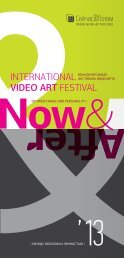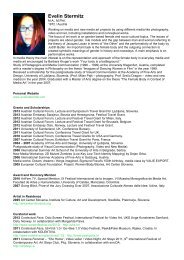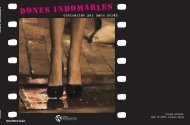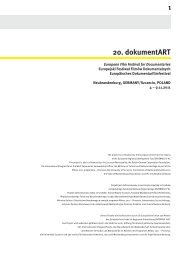NINA SOBELL - Evelin Stermitz
NINA SOBELL - Evelin Stermitz
NINA SOBELL - Evelin Stermitz
Create successful ePaper yourself
Turn your PDF publications into a flip-book with our unique Google optimized e-Paper software.
<strong>NINA</strong> <strong>SOBELL</strong><br />
Gallery AREA 53
Nina Sobell<br />
Galerie AREA 53<br />
Kuratiert von <strong>Evelin</strong> <strong>Stermitz</strong><br />
Die Ausstellung zeigt Video Arbeiten der Künstlerin Nina Sobell in einem miteinander verbundenem performativen<br />
Kontext. Während der Ausstellung arbeitet Nina Sobell an einer skulpturalen Installation in einem offenen Atelier-<br />
Raum als ein Projekt innerhalb der Galerie und Ausstellung.<br />
Nina Sobell ist Pionierin der künstlerischen Verwendung von Video, Computer und Interaktivität sowie<br />
Webperformances. Seit 1969, als sie Video zuallererst verwendete um die ungesteuerten Interaktionen ihrer<br />
Skulpturen mit den Betrachtern zu dokumentieren, untersucht sie den Bereich in welchem Video es ihr erlaubt die<br />
Beziehung zwischen Zeit und Raum zu manipulieren, und einen Bereich für menschliche Erfahrung zu formen, in<br />
welchem das mediatisierte Ereignis sich mit der öffentlichen Erfahrung, Erinnerung und Beziehungen überschneidet.<br />
Vorangegangene künstlerische Arbeiten in diesem Bereich sind ParkBench, VirtuAlice und das fortlaufende Projekt<br />
Interactive Encephalographic Brainwave Drawings.<br />
Nina Sobell präsentierte ihre Arbeiten Brainwave Drawings und Videophone Voyeur (1977) bei Joseph Beuys Free<br />
International University auf der Documenta 6 und erhielt Auszeichnungen (NEA und NYSCA) für ihre Pionierarbeit<br />
in der Video-Performancekunst im Jahr 1970.<br />
Während der Jahre 2007 – 2008 ist Nina Sobell Artist in Residence in Location One New York, unterstützt von der<br />
Andy Warhol Foundation, und ihre Arbeiten werden in der Ausstellung California Video im Getty Museum,<br />
Los Angeles, gezeigt.
„Working with time, perception, exploring cognitive theories as art, led me further into the non-static world of video.<br />
At this point, I needed to retreat into an intimate personal dialogue, making sculpture for video camera space only,<br />
compressing time and private experience.“ —Nina Sobell<br />
Als eine New-Yorker Künstlerin, produzierte Nina Sobell ein großes Spektrum an Arbeiten, welche unterschiedliche<br />
Themen, Strategien und Medien wie Video, Performance, Installation, Skulptur und Live-TV beinhalten. Beteiligt<br />
an der feministischen Performance-Bewegung in den 1970er Jahren, reichen ihre konzeptuell basierenden Arbeiten<br />
von Tabu-Performances und musealen Installationen zu interaktiven Video Matrixen zur öffentlichen Partizipation.<br />
Durch das Erforschen von Video-Skulptur war Nina Sobell interessiert psycho-soziale Transformationen mittels<br />
Videotechnologie zu gestalten, Umgebungen und mobile Strukturen zu schaffen, um den Betrachter physisch mit<br />
einzubeziehen. Weiter geführt wurden diese Videoarbeiten im Bezug zum Unterbewusstsein in ihrem bekanntem<br />
Brainwave Drawing Werk, in welchem ein Bildschirm Gedankenströme von zwei Menschen aufzeichnet und ihre<br />
stille, gemeinsame Kommunikation darstellt.<br />
Nina Sobell erforschte das Vorhandensein von Technologie um das Verhalten von Menschen zu modifizieren und<br />
aufgrund der Möglichkeit der mediatisierten Erfahrung Raum und Zeit zu manipulieren. Dieses Phänomen wurde<br />
dafür benutzt um eine soziale Raumskulptur zu bilden, wobei die verwendeten Technologien eine Stütze für die<br />
Beteiligten bilden, um ihnen die Erlaubnis zu geben verschiedene Arten von -- physischen und sozialen -- Grenzen<br />
zu überschreiten um miteinander zu kommunizieren.<br />
www.ninasobell.com
Nina Sobell<br />
Gallery AREA 53<br />
Curated by <strong>Evelin</strong> <strong>Stermitz</strong><br />
The exhibition shows video works by the artist Nina Sobell in an inter-relative performative context. During the<br />
exhibition Nina Sobell creates a sculptural installation in an open atelier space as an in-gallery project.<br />
Nina Sobell pioneered the use of video, computers, and interactivity in art, as well as performance on the Web. Since<br />
1969, when she first used video to document participants’ undirected interactions with her sculptures, she investigates<br />
the extent to which video enables her to manipulate the relation between time and space, and to create a vortex<br />
for human experience, in which the mediated event coincides with public experience, memory and relationships.<br />
Groundbreaking projects include ParkBench and VirtuAlice, and the ongoing Interactive Encephalographic Brainwave<br />
Drawings.<br />
Sobell presented Brainwave Drawings and Videophone Voyeur (1977) at Joseph Beuys’ Free International University<br />
at Documenta 6. She received awards from the NEA and NYSCA for her pioneering video performance art in the<br />
1970’s. Her work has been shown throughout the US, Europe, and Japan. An award-winning printmaker and figurative<br />
sculptor, and avid improvisational guitarist and keyboardist, she can be seen sculpting Emily in the ParkBench<br />
Performance Archives and heard playing music there as well.<br />
During the years 2007 - 2008 Nina Sobell is Artist in Residence at Location One in New York, supported by the<br />
Andy Warhol Foundation for the Visual Arts and her works are included in the exhibition California Video at the<br />
Getty Museum, Los Angeles.
„Working with time, perception, exploring cognitive theories as art, led me further into the non-static world of video.<br />
At this point, I needed to retreat into an intimate personal dialogue, making sculpture for video camera space only,<br />
compressing time and private experience.” —Nina Sobell<br />
As a New York-based artist, Nina Sobell has produced a broad body of work embracing various themes, strategies, and<br />
mediums, including video, performance, installation, sculpture and live TV. A participant in the feminist performance<br />
movement of the 1970s, her conceptually based work ranges from taboo performances and museum installations to<br />
interactive video matrixes for public participation. Sobell began using video in the 1970s as a way to study spectators’<br />
interactions with her sculptures, which were placed anonymously in public areas. Exploring video-sculpture, Sobell<br />
was intrigued with creating psycho-social transformations via video technology, making environments and mobile<br />
structures to physically engage the viewer. Pursuing video’s relation to the subconscious led Sobell to her well-known<br />
Brainwave Drawing piece, in which a screen monitor registered the brainwaves of two people and their silent attempt<br />
to communicate with each other.<br />
Nina Sobell discovered that the very presence of technology alters peoples’ behavior, due to its capacity to mediate<br />
experience, to manipulate space and time, and due also to peoples’ belief in its power. She has used these phenomena<br />
to sculpt social space. In other words, she has used technology as a prop to give participants permission to overcome<br />
various types of boundaries -- physical and social -- to communicate with one another.<br />
www.ninasobell.com
I Say I Am: Women‘s Performance Video from the 1970s.<br />
by Maria Troy<br />
The feminist movement, with its drive to problematize female subjectivity, validate personal history, and change the<br />
position of women in society had a profound effect on the artwork women produced during the 1970s. Finding<br />
themselves excluded from traditional art circles, women artists formed collective production and exhibition<br />
organizations including galleries, festivals, publications and workshops. While women artists worked in all mediums,<br />
performance art and video art were perhaps especially appealing because the new mediums had no history of excluding<br />
women.<br />
Performance art in the 1970s was also significant for women artists as a challenge to formalism. It presented a means<br />
to negate the division between art and life, to explore relational dynamics between artist and audience and to understand<br />
art as social and experiential. This had special meaning for women artists whose role in art history had been as<br />
model not maker, muse not master. Reconceptualizing their role as artists in part by controlling the presentation of<br />
their bodies on stage, women‘s body art had particular potential to destabilize the structure of conventional art history<br />
and criticism.<br />
Video extended the impact of performance, adding the possibility of remote and future audiences for a one-time<br />
presentation. Through video, the performance could become endlessly present, always enacted for the first time.<br />
The video camera also changed the nature of performance, enabling an intimacy in which artists would do things in<br />
front of a camera that they may not do in the presence of live audiences. When incorporated as an element in live<br />
performance, video equipment altered the experience of theatrical space by disrupting spatial continuity and adding<br />
a layer of technologically mediated presence and reception. Both male and female artists such as Willoughby Sharp,<br />
Lynda Benglis, Vito Acconci and Joan Jonas utilized this distance/intimacy to explore a range of psychosocial and<br />
psychosexual relations.
As a widely-heralded revolutionary medium, women looked to video to advance their own liberatory agenda through<br />
video. Particularly important to the woman performance artist is the ability through video to create time and space,<br />
which she then controls ...While performance opportunities in the gallery establishment were not always available to<br />
women, video technology was accessible through schools and newly founded cooperatives. Within this technological<br />
discourse, women artists created a new performance place ... Most importantly, video time and space allowed the<br />
woman artist to acknowledge her own voice without interruption.<br />
The subject matter of 1970s feminist performance video was personal, often articulated in the direct address of an<br />
artist performing alone. Autobiography, identity, relation of self to others, questioning of female stereotypes, and the<br />
expansion of self through personae were recurrent themes. (Chris Straayer)<br />
They complicate the personal and the political, and assert this intersection as a negotiation that remains fundamental<br />
to the formation of a subject in social space. Consumer-grade portable video equipment was simple enough to be<br />
operated without technical training and light enough for most women to handle. Portable broadcast television<br />
production, which required more specialized equipment and knowledge, was and still is largely a male-dominated<br />
realm.<br />
The tapes collected in I Say I Am share certain aesthetic qualities which are derived from the practical limitations of<br />
early video technology – long takes, little or no editing, little or no camera movement, and direct address of the viewer.<br />
These common characteristics served as formal elements that positioned early video in opposition to television, as an<br />
art form concerned with duration, perception and artistic process. Early video art owed more to Minimalism and<br />
Conceptualism than to Madison Avenue or Hollywood. And compared to commercial mass media, these tapes are<br />
difficult to watch. They are too slow, too private, too confrontational on the level of viewer expectations and attentional<br />
time; they are too opposed to what David Antin called television’s „money metric“, the rigid fragmentation of<br />
television time into 15, 30, and 60 second slices.<br />
www.vdb.org/resources/isayiamessay.html
Hey, Chicky !!!<br />
Nina Sobell, 1978<br />
09:18 Min<br />
In her performance art video Hey! Baby Chickey Nina Sobell appears nude playing with a raw cooking chicken. With<br />
a few simple manipulations, she eradicates the cultural distance between mother and woman as sexual being. Playing<br />
on the symbolic connection between food and sex, cooking is transformed into sexuality, but the involvement of the<br />
dead chicken pushes that sexuality towards bestiality and necrophilia. The scene is further complicated when the same<br />
chicken is given the role of baby. Sobell plays with the chicken, rocking it, holding it up by its arms as if teaching it<br />
to walk, and swinging it from breast to breast in what can only be described as a milking dance. This collapsing of the<br />
baby role with the chicken’s already established roles of dead animal, food material, and sexual object violates other<br />
taboos, including infanticide, cannibalism, and pedophilia.<br />
Chris Straayer, Deviant Eyes, Deviant Bodies: Sexual Re-orientations in Film and Video,<br />
Columbia University Press, New York, 1996<br />
Challenging the dominant ways of making and critiquing art,<br />
feminist art practice in the 1970s stressed personal connections<br />
to materials and immediacy of context over formal abstraction.<br />
For many women, the home was a natural subject of artistic<br />
production as a highly charged site of rampantly contradictory<br />
meanings. As Lucy Lippard noted, (women artists) work from<br />
such (household) imagery because it’s there, because it’s what<br />
they know best, because they can’t escape it.<br />
The artists explore domestic issues such as motherhood, sexuality,<br />
death, familial relationships, control of physical space and the<br />
preparation and consumption of food.<br />
Maria Troy, Desire and the Home: Program 1
Hobby Horses in Paradise and Murder with Mother<br />
Nina Sobell, 1982<br />
19:09 Min<br />
To be honest the title is from a play by Tom Stoppard and the opening lines of this performance triptych are directly<br />
quoted from his work and I never got permission of any kind to have done that so I’m always trying to fudge that and<br />
have started calling the whole thing „Into the Pot You Go” and not even sometimes playing the first part which starred<br />
Chris Shearer - Cori’s dad. In the first part: I am riding on a huge rocking horse (called a hobby horse) he made. Chris<br />
is on a treadmill walking backwards and Benjamin is walking around. We’re quoting lines from the play about how<br />
art does not make compromises and always breaks its promises. Then comes a scene where Chris plays my mother in a<br />
reenactment of the actual night of her shooting me and herself and me running for help through the snow, then comes<br />
a scene with baby chicky where I am asking baby chicky to identify itself by looking at different drawings. Then I am<br />
trying to teach baby chicky how to walk and talk. I warn baby chicky that if it isn’t able to walk or talk then it will have<br />
to go into a pot and be cooked and eaten because in our society if you can’t walk and can’t talk you aren’t much good<br />
and of no use to anyone, so alas baby chicky ends up in the pot. The very weirdest thing about this tape is - Cori wasn’t<br />
born yet and ended up not able to walk or talk. Another weird thing is, as much and as many times my mother tried to<br />
kill herself and me, I ended up giving up everything to try to save Cori’s life. Exhumed is about that effort.<br />
„If you can’t walk and can’t talk then into the pot you go and Jake would like to eat you too”, she adds. Then back to the<br />
reenactment, a video this time of me running through the field to the neighbours to get help, snow and wearing blood<br />
stained pajamas with feet.<br />
Nina Sobell
Glass Breaking and Jumpset<br />
From1971-75 I lived in Venice, California during a time when a number of artists (Chris Burden, William Wegman,<br />
John Sturgeon) were experimenting with the interface between video and performance. This rich and productive time,<br />
gave birth to a new genre called conceptual video performance art: the camera as audience, the video monitor as catalyst.<br />
Intervals (1973), consists of several sequences of work: spherical objects, dancing, the absurd side of sexuality, and glass<br />
breaking. It begins with Flip Flop, a flaccid penis bounces in rhythm against a bouncing woman’s buttocks and breasts;<br />
when the penis hardens, the piece ends. It is followed by two people kissing repeatedly, quickly as if competing in a<br />
marathon, and what appears to be a still arrangement of mirrors is disrupted by a comical cardboard tube moving in<br />
to destroy the illusion. Jumpset, reminds me of the very early influence that DaDa and the Theater of the Absurd has had<br />
upon my work and my life.<br />
Description of Glass Breaking: once a week for several months, I would make the rounds to all the window and auto<br />
glass shops in the Santa Monica and Venice area returning with boxes of glass and mirror shards that they saved for<br />
me. Without wearing any protective gear, I positioned each piece very deliberately in the same place; striking it with<br />
only one hammer blow. The fragments broke in a consistently circular pattern, and formed over time into pristine glass<br />
and mirror mounds with depressions at their tops. The glass mound gleamed with variegated blue and green from<br />
refractions. Newly created layers made settling sounds like delicate glass chimes tinkling in contrast to the forceful<br />
cracking sounds that made them. My only incidence of injury occurred when I was not in a meditative state of mind.<br />
I cut my hand picking up a piece of glass, when I was not completely calm and concentrating on what I was doing.<br />
I could have blinded myself. The piece demanded the absence of protective gear; it was essential to its integrity. The<br />
piece was conceptual in its formality, its precision of action and design. My action created an object that was born<br />
from the calmness of its execution, and the simultaneous threat of injury. The piece could have been misconstrued as a<br />
release of frustration, but quite the opposite was the essence of the work. The camera intimately tracks my movements<br />
and expressions. I wanted to reveal the point between thought and experience where perception occurs. Physical<br />
manifestations appear in the close surveillance of my actions in a repeated cycle: from my eyes, to my mouth, to my<br />
hands, to the glass(work) and back to my eyes. For me, it is a highly disciplined mental, physical and metaphysical<br />
revelation of art in the making.
Jumpset: Two cameras are focused on two couples, one at each end of a couch. Two (m/f ) couples are sitting on the<br />
couch. Each one converses with the other’s partner; two are leaning forward while the other two are leaning back<br />
alternately. They are partially undressed. The men have their pants off, keeping on their shirts; the women are bare<br />
breasted keeping on their pants. They converse with no particular acknowledgement of their partial nudity. At both<br />
ends of the couch, there are closed circuit monitors, each person on the couch is able to see themselves. Another<br />
camera is focused on a couple (m/f ) in close proximity to the couples on the couch, who are jumping and bouncing to<br />
a consistent beat. The man stands on a stool, his flaccid penis flopping level with the woman’s flopping breasts. Another<br />
camera focuses on posted phrases like „Transient Pleasures” and „When the Talking is Over, the Silences are Worth<br />
Waiting For”. In interface, the images appear randomly, intermittently with no fixed time or expected result. It’s a play<br />
upon the typical cocktail party mentality; each one fantasizing about the other, more interested in their own images,<br />
and subtext conversations they are having with themselves.<br />
Nina Sobell
Elastic Equations<br />
Nina Sobell, 1972-73<br />
17:18 Min<br />
As the camera watches itself simultaneously in both a mirror and a monitor, the artist interposes her foot, and, on the<br />
sound track, we hear her say „It’s just a matter of stepping into infinity”. A wry comment to be sure, but nevertheless<br />
one that paradigmatically summarizes the seriousness of her concerns. Elastic Equations explores images that are so<br />
condensed, so archetypically structured, that they approach the definition of the absolute. Utilizing her experience in<br />
sculpture, Sobell discovers a series of environments in which the self and images of infinity are created. She makes<br />
succinct use of video medium’s potential for self-analysis (mirrors, monitor feedback, 8mm film projected onto the<br />
monitor, dusty windows, etc.) and in her work the camera itself is alternately an observer of self and the means of<br />
perception. Elastic Equations is a lyrical work, characterized by formal, empathetic rhythms and images of subliminal<br />
power.<br />
David E. James, Art+Cinema, 1974
Elements<br />
Nina Sobell, 1973<br />
22:14 Min<br />
As implied by its title, Elements is a basic grammar of video motion, an exploration of the relationship between abstract<br />
(ideal) movement and movement as it occurs in real images and situations. In it a limited number of units of rhythm,<br />
of image, and of sound are manipulated through different combinations and permutations. For example, the opening<br />
sequence simply shows a number of different body movements all with a common rhythmic structure (tap dancing,<br />
barefoot dancing, kissing) along with sound patterns that alternately correspond with the image or are independent<br />
of it, sometimes produced by the image and sometimes discreet from it. Proceeding in sophistication from this point,<br />
the tape develops images of specific motions in different contexts (a falling paper, a huge sheet of polythene, falling<br />
paper ash), or of a specific kind of image produced in different ways (fire from gas rings, a burning pier, burning<br />
paper). Many of the images are (or are revealed to be) extremely beautiful in their own right, but it is the thematic<br />
and structural coherence of this tape, the clarity and precision of its development that make viewing it so exciting and<br />
rewarding.<br />
David E. James, USC Cinema Studies, 1974
Nina Sobell Pioneer in Interactivity<br />
Documentary by Emily Hartzell, 1993<br />
31:18 Min
Biography Nina Sobell<br />
BFA Tyler School of Art, Temple University, Philadelphia, Pennsylvania<br />
MFA Cornell University, Ithaca, New York<br />
Professional Recognition and Appointments<br />
2008 BrainChat U. S. patent<br />
2007-08 Artist in Residence at Location One, New York, Andy Warhol Foundation for the Visual Arts<br />
2005-06 Visiting Lecturer, Goldsmiths College, University of London UK<br />
2002 Rockefeller Foundation Fellowship Nominee in Media Arts<br />
2001 New York State Council for the Arts, Artist Fellowship<br />
1999 Webby Award Nominee, ParkBench On-Line Collective<br />
1998 Turbulence.org Commission, with S. Allin and J. Gilbert<br />
1998 Artist-in-Residence, Banff Centre for the Arts, Canada<br />
1994-98 Artist-in Residence, Center for Advanced Technology, Courant School of Computer Science, New York<br />
University<br />
1991-93 Artist-in-Residence, Interactive Telecommunications Program, Tisch School of the Arts NYU<br />
Solo Shows and Collaborations<br />
2008 Nina Sobell, solo show, Gallery Area 53, Vienna, Austria<br />
Artist in studio as Spectacle: Internal Message Search, solo show, Location One Gallery, NY<br />
2006 Reap, Video Collaboration, Anne Bean Matt’s Gallery, London, UK,<br />
Video Documentary of Zambian Street Theater Group with Anne Bean<br />
2001 Liwase,Video Documentary of Zambian Street Theater Group with Anne Bean<br />
1998 Interactive Installations, 1974 - 1998, DAAD Studios, Berlin with Emily Hartzell<br />
1998 Ebb and Flow, Web performance, Morton Studio, turbulence.org ( J.Gilbert/S.Allin)
Group Shows and Collaborations<br />
2008 Waves-The Art of the Electromagnetic Society, Hartware Medien Kunstverein, Dortmund, Germany<br />
California Video, Getty Museum, Los Angeles, California<br />
2007 Evidence of Movement, Getty Research Institute, LA, Ca.<br />
Cyber Feminism Past Forward, Austrian Association of Women Artists, Vienna<br />
The Future of the History, Space Gallery, New York<br />
Slapstick, curated by C. Eammons, Lora Reynolds Gallery, Austin, Texas<br />
2006 KISSS. Whitechapel Gallery, London, UK/Sidney, Australia<br />
2005 Art/ Sound, curated by J. Slater, Front Room Gallery , Williamsburg, NY<br />
2004 Synaesthesia, Thinking of You, Institute of Contemporary Art, London UK<br />
2002 Art/Women/California 1950-2000, San Jose Museum of Art, San Jose, Ca.<br />
2000 Sharing a Shadow, Three Colt Gallery, London<br />
1999 Streaming: A Laboratory, with E. Hartzell/ Sonya Allin, W. Phillips Gallery, Banff<br />
Sunshine & Noir: Art in Los Angeles 1960-1997, UCLA at The Armand Hammer<br />
Castello di Rivoli, Italy, Kunstmuseum Wolfsburg, Louisiana MOMA, Denmark<br />
1997 Dance in a Moving Mirror streaming with Hartzell/Gilbert, RAT, Aix-en-Provence<br />
Adrift (web performance), Ars Electronica with Gilbert, Hartzell, Thorington, Wolsak<br />
Pink Wink, New Image Art Gallery, Los Angeles<br />
Pasarse de la Raya, Expoarte, Guadalajara, VI Feria Internacional de arte Contemporaneo<br />
PORT, four-screen web projection performance, MIT List Visual Arts Center<br />
Blast5, Time Curators and web/video installation (ParkBench), Sandra Gering Gallery<br />
1996 Art on the Web (ParkBench), Whitney Museum of American Art<br />
Language and Disorder: videotapes, New Langton Arts, San Francisco<br />
1995 Alice Sat Here, telerobotic installation w/Hartzell in CODE, Ricco/Maresca Gallery, NYC<br />
1993 LA Sampler 1970-1993, Hey, Baby Chicky! P.McCarthy curator, David Zwirner Gallery, NYC<br />
Scratching the Belly of the Beast, Brainwave Drawings, Los Angeles Film Forum
1992 Installation: painting, sculpture, and 2 channels of video, Granary Books Gallery, NYC<br />
Brainwave Drawing Installation, Bronx River Arts Center, Bronx, NY<br />
1991 Drawings, Elston Fine Arts Gallery, New York, NY<br />
Cori: Struggle for Life, video work, Speaking Out: Art Against AIDS, Museum of Modern Art, NY<br />
1990 Cori: Struggle for Life, Video Against AIDS, Institute of Contemporary Art, London,<br />
The Indomitable Spirit, video work, International Center for Photography, NY<br />
Beyond Boundaries: Paintings, Black and White in Color Gallery, Bronx, NY<br />
Bibliography<br />
“Nina Sobell: Tecnology and Art” by Padraig Thomas, summer term | issue 21 | Research Hallmark Journal, (2005) U<br />
of London, UK <br />
“What Franklin Furnace Learned” by Martha Wilson , Leonardo, MIT Press, Vol. 38, No. 3, pp 193,194 (2005)<br />
“Closed Circuit Video Installations” by Slavko Kacunko, Logos Verlag, Berlin (2004) , p. 395,408,409,483,487,1129<br />
“Sci-Art: Exploring the Brain and the Role of the Artist” by Mina Liza, NY Arts, vol. 8, no.4(April 2003), p. 58,59<br />
“Digital Art” by Christianne Paul, Thames and Hudson, (2003) p. 160 <br />
“Postmodern Currents: Art and Artists in the Age of Electronic Media”, by Margot Lovejoy, Prentice Hall, 2003<br />
(third edition)<br />
“Art/Women/California1950-2000” editors Burgess/Salvioni, University of California Press and the San Jose<br />
Museum of Art (2002), p. 326<br />
“Streaming the Brain” by N. Sobell, MultiMedia, Artful Media ed. Doree Duncan Seligmann IEEE Computer<br />
Society, Vol. 9, No. 3 ( July-September, 2002), p. 3-8<br />
“Info Arts-Intersections of Art, Science, and Technology” by S.Wilson, MIT Press (2002)<br />
“Sculpting in Time and Space: Interactive Work” by Nina Sobell and Emily Hartzell, Leornardo, MIT Press, Vol.34,<br />
No.3 (2001)<br />
“Robot in the Garden” by Ken Goldberg, MIT Press (2000), p. 15<br />
“Going Virtual” by Martha Wilson, CAA Art Journal, Summer, 2000
“Artful Media,” by Kathy Brew, IEEE Multimedia, 1999<br />
“Women in Art and Technology” edited by Judy Malloy., MIT Press 1999<br />
“A Brief History of Outrage: The 51 (or So) Greatest Avant-Garde Moments,” by C. Carr, Village Voice, September<br />
22, 1998<br />
“On Edge: The Heart of the Web,” by C. Carr, Village Voice,Vol. 42, No. 25 ( June 24, 1997), p. 50<br />
“VirtuAlice,” by Sobell and Hartzell, Ylem , Vol. 17, No. 9, (September/October, 1997), p. 5<br />
“Telepresence Art,” by Eduardo Kac, Art Journal, College Art Association, 1997<br />
“Naked to the Bone”, by Betty Ann Kevlis, Rutgers University Press, 1997<br />
“Postmodern Currents: Art and Artists in the Age of Electronic Media”, by Margot Lovejoy, Prentice Hall, 1996<br />
(second edition)<br />
“ParkBench,” interview with Doug Grunther, WDST Woodstock Radio, October, 1996<br />
“ParkBench Public Access Kiosks,” Visual Proceedings, Siggraph ‘96<br />
“ParkBench Sculpting Performances,” The Acid-free Paper (web journal), edited by Kevin Smith, Vol. 1, No. 4<br />
( January, 1996),<br />
Net Culture section.<br />
“Deviant Eyes, Deviant Bodies” by Chris Straayer, Columbia University Press, 1996<br />
“Art Online” by Robert Atkins, Art in America, Vol. 83, No. 12 (December, 1995), p. 64<br />
“Technology: Do You Mind if I Sit Here?” by Kimberly Neuhaus, I.D.,Vol. 42, No. 2 (March-April, 1995), p. 24<br />
“ParkBench,” Artists’ Pages by Emily Hartzell and Nina Sobell, Felix: Landscape(s) Vol. 2, No.1 (1995), pp. 302-5<br />
“Interactions”, Vol. IV, No. 2, June, 1992 and Vol. III, No. 1, April, 1991<br />
Felix (review of EXHUMED & Video 1972-90), Vol. 1, No. 1 (Spring, 1991), p. 71-73.
Public Collections<br />
Archivo Storico delle Arti Contemporane; La Biennale di Venezia, Italia; Museum of Modern Art, NY; Long Beach<br />
Museum of Art, Long Beach, CA; Whitney Museum of American Art; Banff Centre for the Arts, Canada; deSaisset,<br />
Museum of Art; Manchester Museum of Art, England; Reading University, England; Contemporary Arts Museum,<br />
Houston, TexasArts; Zentrum fur Kunst Und Medien Technologie, Karlsruhe, Montevideo, Amsterdam; Institute<br />
of Contemporary Art, London; Western Front Video, Vancouver; DIA Foundation; Cologne; Kramlich Video<br />
Collection, and other private collections and academic institutions.
Nina Sobell<br />
July 8 - August 1 2008<br />
Gallery AREA 53<br />
Gumpendorferstrasse 53<br />
A-1060 Vienna<br />
www.area53.name<br />
Art project AREA 53 by TWO PEOPLE ONE WORK - Karin Sulimma & Mounty R. P. Zentara<br />
Exhibition catalogue edited by <strong>Evelin</strong> <strong>Stermitz</strong> 2008


